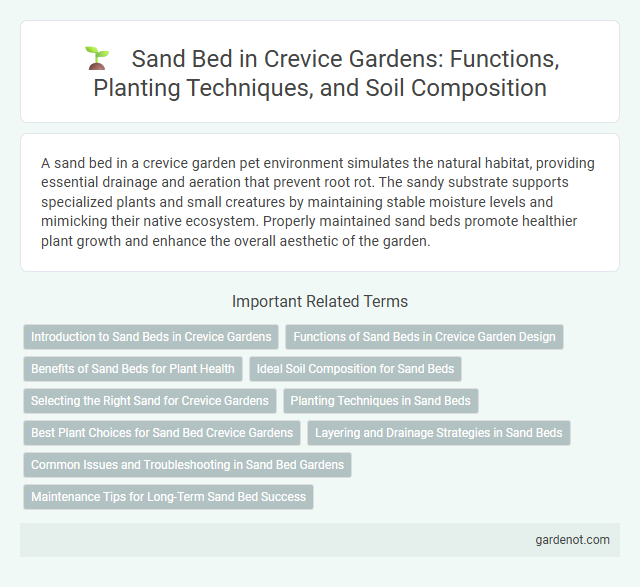A sand bed in a crevice garden pet environment simulates the natural habitat, providing essential drainage and aeration that prevent root rot. The sandy substrate supports specialized plants and small creatures by maintaining stable moisture levels and mimicking their native ecosystem. Properly maintained sand beds promote healthier plant growth and enhance the overall aesthetic of the garden.
Introduction to Sand Beds in Crevice Gardens
Sand beds in crevice gardens provide excellent drainage and mimic natural alpine environments, essential for the health of drought-tolerant plants. These beds consist of coarse, well-graded sand layers that prevent water retention and encourage strong root development. Proper installation of sand beds promotes aeration and minimizes soil compaction, supporting a diverse range of succulent and rock-loving species.
Functions of Sand Beds in Crevice Garden Design
Sand beds in crevice garden design enhance drainage by preventing waterlogging in deep, narrow planting gaps. They provide stable anchorage for alpine and drought-tolerant plants, supporting root growth in well-aerated, nutrient-poor substrates. These beds also regulate soil temperature, creating optimal microclimates essential for sensitive crevice garden flora.
Benefits of Sand Beds for Plant Health
Sand beds provide excellent drainage, preventing root rot and promoting healthy root development in crevice garden plants. Their porous structure enhances aeration, allowing oxygen to reach plant roots more efficiently. This environment supports drought-tolerant species and reduces soil-borne diseases by minimizing moisture retention.
Ideal Soil Composition for Sand Beds
The ideal soil composition for sand beds in crevice gardens consists primarily of coarse sand mixed with organic matter such as compost to enhance moisture retention and nutrient availability. A well-draining substrate with a ratio of roughly 70% coarse sand to 30% organic material promotes healthy root growth and prevents waterlogging. Incorporating small amounts of perlite or fine gravel further improves aeration and mimics natural rocky environments found in alpine crevice habitats.
Selecting the Right Sand for Crevice Gardens
Choosing the right sand for crevice gardens is crucial for optimal drainage and plant health, favoring coarse, angular sand over fine, rounded grains to ensure stability and prevent compaction. High-quality quartz sand with a particle size between 1 to 3 millimeters enhances aeration and supports root growth in narrow planting spaces. Avoiding salt-rich or clay-contaminated sand helps maintain a neutral pH and prevents moisture retention issues that could harm drought-tolerant plants typical of crevice gardens.
Planting Techniques in Sand Beds
Planting techniques in sand beds require careful soil preparation to ensure proper drainage and root aeration, essential for crevice garden success. Selecting drought-tolerant, shallow-rooted plants like sedums and alpine species helps optimize moisture retention while accommodating sand's quick-draining properties. Incorporating organic matter and fine gravel in the sand bed improves nutrient availability and stability, promoting healthy plant growth.
Best Plant Choices for Sand Bed Crevice Gardens
Succulents such as Sedum, Sempervivum, and Agave thrive in sand bed crevice gardens due to their drought tolerance and shallow root systems. Aromatic herbs like thyme and lavender also perform well, benefiting from excellent drainage and minimal water retention in sandy substrates. Selecting native grasses and drought-resistant perennials enhances the garden's resilience while complementing the natural crevice environment.
Layering and Drainage Strategies in Sand Beds
Sand beds in crevice gardens employ strategic layering to enhance drainage and root aeration, typically alternating coarse sand with finer particles to prevent clogging and compaction. Proper drainage is ensured by incorporating a base layer of gravel or small stones, which facilitates water flow and prevents waterlogging. This layering approach mimics natural alpine environments, supporting drought-tolerant plants by maintaining balanced moisture levels and preventing root rot.
Common Issues and Troubleshooting in Sand Bed Gardens
Sand beds in crevice gardens often face drainage problems that can lead to root rot in plants like sedums and alpine species. Compaction of the sand layer reduces aeration, causing poor root development and stress in drought-tolerant plants such as sempervivums. Regularly checking for adequate sand grain size and ensuring proper layering with gravel beneath can mitigate common issues like waterlogging and nutrient deficiencies.
Maintenance Tips for Long-Term Sand Bed Success
Regularly raking the sand bed prevents compaction and promotes healthy root growth in a crevice garden. Periodic washing with fresh water removes accumulated salts and debris, preserving optimal drainage. Incorporating organic matter annually enhances nutrient content, supporting plant vitality over time.
Sand bed Infographic

 gardenot.com
gardenot.com